Alaska Fish & Wildlife News
March 2024
A Collared Pika’s Winter
in The Subnivean Realm
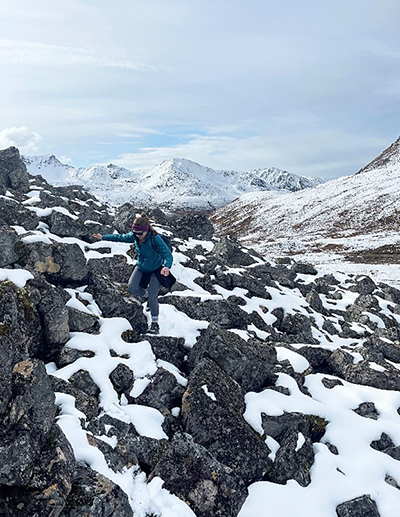
Last autumn I was clambering around on a snowy rockslide in Southcentral Alaska when I found a trail of tiny footprints in the snow. The tracks confirmed that I’d found what I was looking for, the den of a collared pika where I could deploy some temperature loggers for the winter.
Despite the collared pika’s adorable appearance - resembling a mountain gerbil with small round ears - they are not rodents but rather lagomorphs, the same order as rabbits. And unlike their close cousins, American pika, collared pika are only found in Alaska and Canada in isolated populations. Our team had been surveying these pika dens for almost five years and I knew where to find them, and I was grateful that this first snowfall had not made the rockslide completely impassable. The pika’s footprints were not evidence of its last exploration outside before denning up for hibernation, as it might be with many of Alaska’s mammals, but business as usual because the collared pika doesn’t hibernate. How can they survive in the rock crevices buried under snow for nearly nine months out of the year? The answer lies in both their behavior and their environment.
Winter Stores
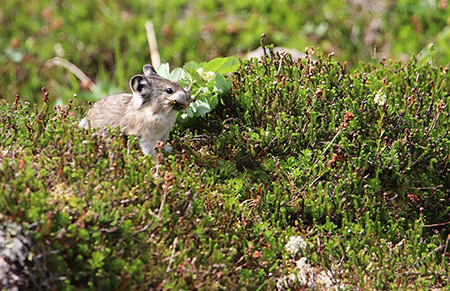
For those who hike through pika territory in the summer, a lucky sight is a collared pika darting across tundra and rocks with a bouquet in its mouth. These pika spend the entirety of the warm summer harvesting grasses, leaves, and flowers to bring back to their den, building huge food stores called haypiles. Many of these large mounds of green plants are easily spotted on a talus slope in pika habitat. Over the years I’ve seen blueberries, lichen, yellow paintbrush, moss, buttercup, geranium, crowberry stalks, willow, and fireweed in pika haypiles. I’ve even seen a pika eat an entire mountain harebell blossom in one bite like a giant violet cupcake as it took a break from collecting food, or haying.
The pikas attend to these haypiles with meticulous care, rearranging the leaves and adjusting the placement of each piece throughout the season. They are ensuring that the haypile dries in just the right way so it will preserve throughout the winter. In addition to this care, the pika chooses plants for their haypile based on their nutritional quality and how well they will store over time. If they have a choice, they avoid woody shrubs like blueberry and seek out those with a low tannin concentration after drying, like flowers and willow. Fireweed is one of their favorites.
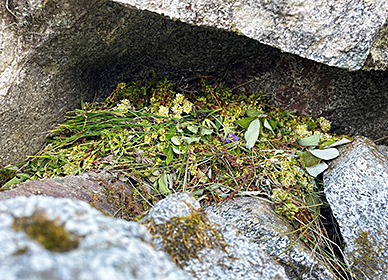
Having all your grass in one haypile can be tricky though as marmots prowl the slopes along with ground squirrels, birds, and other pika. These interlopers steal from haypiles and can destroy entire stores. Predatory ermine and raptors stalk the rocks after the harried pika. Many pikas will have satellite haypiles close to their main one to hedge their bets, sometimes having a dozen different little haypiles scattered throughout the slope. The pika is protective of these precious haypiles and will squeak defensively and chase away other pika who enter their domain. It’s the pika with a stocked and well-kept haypile who has the best chance of making it through the winter.
A Roof Overhead

Now they have a freezer full of their winter food stores, how do they stay warm during the long months under deep snowpack in the mountains? Snow is an incredible insulating material and many animals that are active in winter make use of this fact by burrowing down in it to create little snow caves and nests. Arctic foxes dig down into the snow and curl up to keep warm in a storm, as do Willow Ptarmigan. But if you’re small enough to roam underneath the snowpack in the “subnivean realm” you can experience a remarkable temperature difference. The temperature loggers I had put out in the rockslide sometimes recorded a contrast of 13-18° C between the open air and the inside of a pika den during winter. These temperatures were one of the elements ADF&G considered in how successful a pika territory is over time, if the pika remains in the area from year to year, or if it abandons the territory.
The pika themselves also grow thicker winter coats to help keep warm and their fluffier forms can be seen on winter game cameras hidden in their dens. The pika spend the winter appearing and reappearing among their haypiles, nibbling the dried leaves, reorganizing the pile, tidying the den, and fussily making sure their stores are arranged just so.
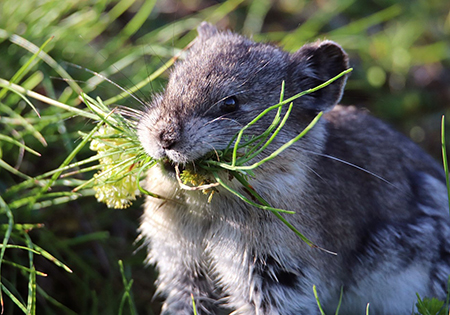
Their ecology can also leave the pika vulnerable to environmental changes. If the snowpack isn’t thick enough, due to wind, rain, or reduced snowfall, the pika can lose the protective layer of insulating snow in winter. Winter rain can dampen or soak haypiles, damaging the pikas’ food store; and a pika with wet fur will struggle to stay warm. Because of this, pika tend to inhabit their territories for longer when winters are colder. Moderate summer temperatures also seemed to suit the pika best, allowing for sufficient plant growth for food while not causing pika undue heat stress. Their southern cousins, the American pika, have been found to be sensitive to these shifts in the environment. Current research in southcentral Alaska by ADF&G is monitoring collared pika populations, their ecology, and what they need to survive so we can predict their resiliency in the future.
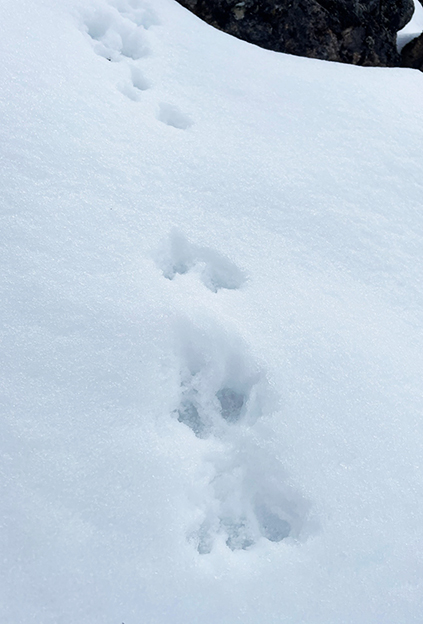
The pikas are under the snowpack now, their haypiles running low. But they wait, just as our field crew does, for the open slopes of summer and the bloom of willow leaves and bright pink fireweed. Then they’ll be hard at work once more, filling the den for the coming winter.
More about temperature loggers and pika research:
Collared Pika - Big Questions about a Little Animal
Tending the haypile in winter
Subscribe to be notified about new issues
Receive a monthly notice about new issues and articles.
